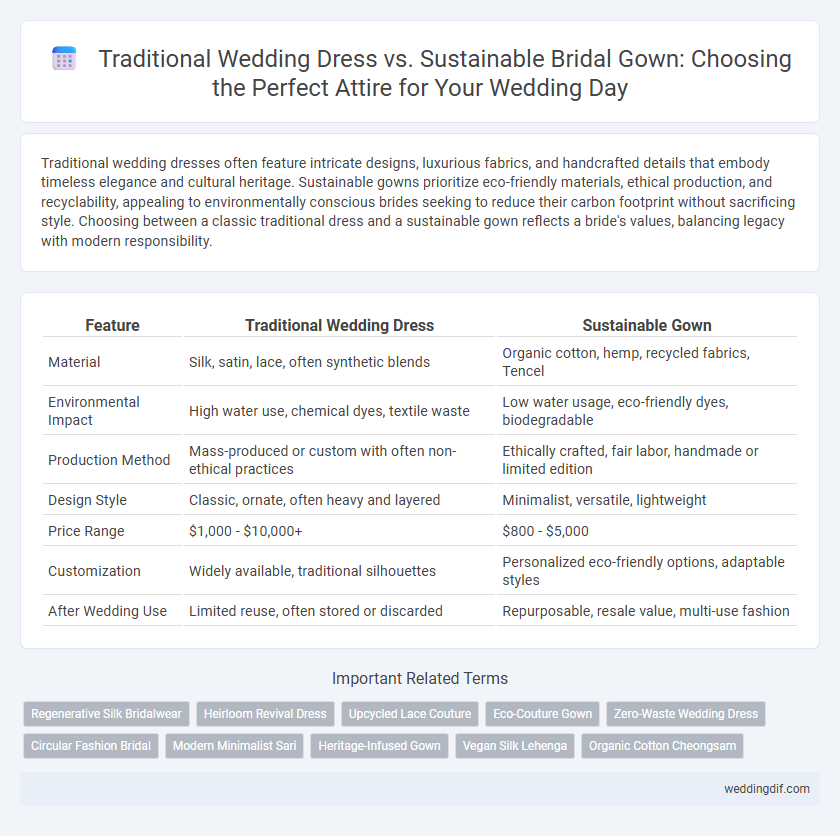Traditional wedding dresses often feature intricate designs, luxurious fabrics, and handcrafted details that embody timeless elegance and cultural heritage. Sustainable gowns prioritize eco-friendly materials, ethical production, and recyclability, appealing to environmentally conscious brides seeking to reduce their carbon footprint without sacrificing style. Choosing between a classic traditional dress and a sustainable gown reflects a bride's values, balancing legacy with modern responsibility.
Table of Comparison
| Feature | Traditional Wedding Dress | Sustainable Gown |
|---|---|---|
| Material | Silk, satin, lace, often synthetic blends | Organic cotton, hemp, recycled fabrics, Tencel |
| Environmental Impact | High water use, chemical dyes, textile waste | Low water usage, eco-friendly dyes, biodegradable |
| Production Method | Mass-produced or custom with often non-ethical practices | Ethically crafted, fair labor, handmade or limited edition |
| Design Style | Classic, ornate, often heavy and layered | Minimalist, versatile, lightweight |
| Price Range | $1,000 - $10,000+ | $800 - $5,000 |
| Customization | Widely available, traditional silhouettes | Personalized eco-friendly options, adaptable styles |
| After Wedding Use | Limited reuse, often stored or discarded | Repurposable, resale value, multi-use fashion |
Understanding Traditional Wedding Dresses
Traditional wedding dresses often feature intricate lacework, silk fabrics, and classic silhouettes such as the ball gown or A-line, symbolizing cultural heritage and timeless elegance. These gowns frequently incorporate hand-stitched embellishments and embroidery that reflect regional craftsmanship and centuries-old bridal customs. Understanding the significance of traditional wedding dresses involves appreciating their historical roots and the symbolic meanings embedded in fabric choices, colors, and design elements.
What Makes a Gown Sustainable?
A sustainable wedding gown prioritizes eco-friendly materials such as organic cotton, hemp, or recycled fabrics that reduce environmental impact. Ethical production practices, including fair labor conditions and minimal waste through zero-waste pattern cutting or upcycling, are essential components. Longevity and versatility in design also contribute to sustainability by encouraging reuse or repurposing beyond the wedding day.
Classic Elegance: Features of Traditional Bridal Attire
Traditional wedding dresses often showcase timeless elements such as intricate lacework, long trains, and structured silhouettes that emphasize classic elegance. These gowns typically utilize luxurious fabrics like satin, silk, and tulle, combined with hand-sewn embellishments and detailed embroidery to create a sophisticated bridal look. The design prioritizes formality and tradition, reflecting cultural heritage and ceremonial significance in bridal attire.
Eco-Friendly Fabrics in Sustainable Wedding Gowns
Sustainable wedding gowns increasingly feature eco-friendly fabrics such as organic cotton, hemp, and bamboo, which reduce environmental impact compared to traditional materials like silk or satin. These fabrics are cultivated and processed with minimal chemical use, promoting biodegradability and reducing water consumption. Opting for sustainable gowns supports ethical production practices and aligns with the growing demand for environmentally conscious bridal attire.
Cost Comparison: Traditional vs. Sustainable Dresses
Traditional wedding dresses typically range from $1,000 to $5,000, often made with luxurious but resource-intensive fabrics like silk and satin. Sustainable gowns, crafted from eco-friendly materials such as organic cotton, hemp, or recycled fibers, usually cost between $800 and $3,500 due to ethical production methods and smaller-scale manufacturing. Choosing a sustainable dress not only reduces environmental impact but can also offer cost savings without compromising on style or quality.
Environmental Impact of Bridal Gowns
Traditional wedding dresses often involve intensive resource use and synthetic materials contributing to significant environmental waste and pollution. Sustainable bridal gowns prioritize eco-friendly fabrics like organic cotton, hemp, or recycled materials, reducing carbon footprint and minimizing textile waste. Choosing sustainable gowns supports ethical production practices and helps preserve natural resources, making them a greener alternative to conventional bridal attire.
Customization and Personalization Options
Traditional wedding dresses often emphasize intricate hand-sewn embellishments and tailored silhouettes, allowing brides to customize elements such as lace patterns, beadwork, and fabric choices to reflect cultural heritage. Sustainable gowns prioritize eco-friendly materials like organic cotton, hemp, or recycled fabrics, while offering personalized designs through modular components, interchangeable details, and customizable fits that reduce waste. Both options provide unique avenues for brides to express individuality, with sustainable attire integrating ethical values alongside bespoke tailoring.
Cultural Significance in Traditional Wedding Dresses
Traditional wedding dresses hold profound cultural significance, embodying heritage through intricate designs, fabrics, and colors that represent the bride's community, history, and values. These gowns often feature handcrafted embroidery, symbolic motifs, and styles passed down through generations, making them a tangible link to ancestral traditions. Unlike sustainable gowns that prioritize eco-friendly materials and production methods, traditional dresses emphasize preserving cultural identity and honoring ceremonial customs.
Bridal Style Trends: Sustainability vs. Tradition
Traditional wedding dresses often feature intricate lace, heavy fabrics, and elaborate embellishments reflecting cultural heritage and timeless elegance. Sustainable bridal gowns prioritize eco-friendly materials like organic cotton, recycled satin, and low-impact dyes, aligning with modern values of environmental responsibility. The bridal style trend balances these elements by offering designs that honor tradition while incorporating sustainable practices to reduce the fashion industry's carbon footprint.
Making the Final Choice: Which Gown Suits You?
When deciding between a traditional wedding dress and a sustainable gown, consider factors such as fabric origin, craftsmanship, and personal values toward environmental impact. Traditional wedding dresses often feature intricate designs and luxurious materials like silk and lace, offering timeless elegance for formal ceremonies. Sustainable gowns utilize eco-friendly fabrics like organic cotton or recycled materials, appealing to brides who prioritize ethical fashion and reducing their carbon footprint on their special day.
Traditional Wedding Dress vs Sustainable Gown for Bridal Attire Infographic

 weddingdif.com
weddingdif.com